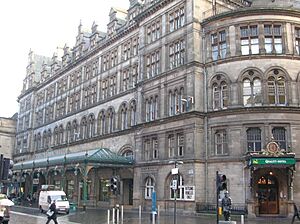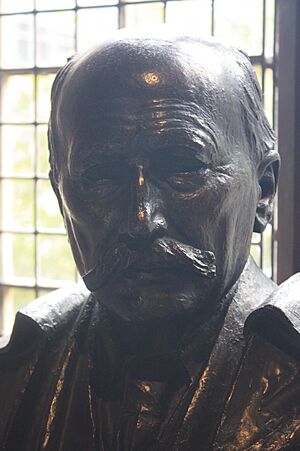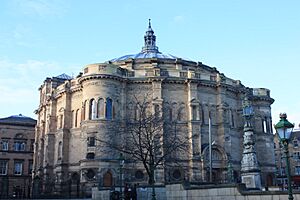Robert Rowand Anderson facts for kids
Quick facts for kids
Robert Rowand Anderson
|
|
|---|---|

Anderson by John M. Aiken
|
|
| Born | 5 April 1834 Liberton, Scotland
|
| Died | 1 June 1921 (aged 87) Colinton, Scotland
|
| Nationality | British |
| Occupation | Architect |
| Buildings | Grand Central Hotel, Glasgow McEwen Hall, Edinburgh |

Sir Robert Rowand Anderson (born April 5, 1834 – died June 1, 1921) was a famous Scottish architect from the Victorian era. He learned his skills in London with a well-known architect named George Gilbert Scott. In 1860, Anderson started his own architecture business in Edinburgh. By 1880, his company was designing some of the most important buildings in Scotland.
His amazing designs include the Scottish National Portrait Gallery and the beautiful McEwan Hall at the University of Edinburgh. He also designed the Central Hotel in Glasgow and Mount Stuart House on the Isle of Bute.
Contents
Early Life and Training
Anderson was born in Liberton, a place near Edinburgh. He was the third child of James Anderson, who was a lawyer, and Margaret Rowand. He went to George Watson's College for his education.
In 1845, he started training to become a lawyer. He even worked for his father's company for a short time. But his real passion was architecture. In 1849, he began studying architecture. He took classes at the Trustees' Drawing Academy, which later became the Edinburgh College of Art. He also trained with an architect named John Lessels.
In 1857, Anderson moved to London. He worked for two years as an assistant to George Gilbert Scott, a very important architect. Many other talented architects also worked there. After this, Anderson traveled to France and Italy to study architecture. He even worked for a short time in the Netherlands.
Starting His Architecture Career
In 1860, Anderson came back to Edinburgh. He started working with the Royal Engineers, who are military engineers. He helped with projects like coastal defenses and a memorial near Edinburgh Castle.
He also helped George Gilbert Scott build St James's Church in Leith. This led to more jobs designing churches for the Scottish Episcopal Church. These early churches showed the influence of Scott's designs.
Anderson opened his own architecture business in 1868. One of his first important projects was restoring a church in St Vigeans in 1871. He also won a competition to design the Catholic Apostolic Church in Edinburgh.
Designing Famous Buildings
In 1874, Anderson was asked to design new buildings for the University of Edinburgh. He traveled around Europe again to get ideas. He then created a winning design in the Italian Renaissance style. This design helped him become a member of the Royal Scottish Academy. The Medical School was finished in 1886, and the amazing McEwan Hall was completed in 1897.
Soon after, in 1876, he became the architect for Glasgow Central Station. In 1878, he designed a new Mount Stuart House for the Marquess of Bute. The old house had been destroyed by fire. He designed it in an Italian Gothic style. The Scottish National Portrait Gallery was also designed in a similar style. It was built using red sandstone.
Later Years and Legacy
In the 1880s, Anderson's style started to include more Scottish historical architecture. This can be seen in buildings like the Pearce Institute in Govan.
From the 1890s, Anderson focused more on restoring old buildings. He had already worked on Iona Abbey and Jedburgh Abbey. Now, he restored Dunblane Cathedral and Paisley Abbey. He also became very involved in teaching. He helped set up a School of Applied Art in 1892. This school later joined with the new Edinburgh College of Art in 1903.
Anderson was made a knight in 1902 for his work at Balmoral Castle, a royal residence. In 1916, he received the Royal Gold Medal for architecture, which is a very high honor.
In 1916, even though he was ill, he helped create the Royal Incorporation of Architects in Scotland. He even gave his own house to be used as its headquarters.
Sir Robert Rowand Anderson retired to Colinton and passed away there in 1921. He is buried in Warriston Cemetery.
The Rowand Anderson Architecture Company
Anderson's architecture company continued after he retired. It went through different partnerships over the years. Famous architects like Basil Spence worked there. Today, the Rowand Anderson Partnership still exists and is based in Rutland Square.
Images for kids




